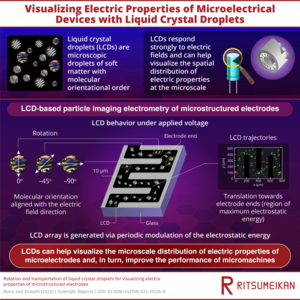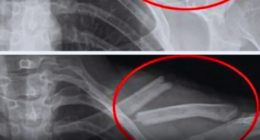Researchers at Ritsumeikan University in Japan have discovered that liquid crystal droplets (LCDs) can be used to visualize the spatial distribution of electric properties of microelectrodes and microelectric devices. Their research offers high spatial resolution and detection accuracy, which traditional sensor probes lack. By observing the rotational and translational behavior of LCDs under an electric field, the team was able to produce an array of LCDs via periodic modulation of the energy density in a micro-capacitive MEMS device. The LCD array served as a periodic modulator of the refractive index, a number characterizing the light bending ability of a material. The study provides valuable information on defect location in microelectrical devices, which was previously unavailable, and opens up possibilities for the development of more sophisticated MEMS technology in the future. Dr. Shinji Bono and Professor Satoshi Konishi led the research, which was supported by JPSJ Grant-in-Aid for Early-Career Scientists and Ritsumeikan University’s Global Innovation Research Organization.
Advancements in Microelectromechanical Systems (MEMS) with Liquid Crystal Droplets
Microelectromechanical systems (MEMS) are devices that consist of micron-sized electrical components, including sensors and actuators, which are integrated into electronic devices such as computers and smartphones. The fabrication of these integrated devices is a challenging task, as they are prone to defects during their production and operation, which can limit their performance. To identify and rectify these defects, it is crucial to measure the spatial distribution of electric properties of these devices accurately.
However, traditional sensor probes can only measure the average electric properties, providing no information on the spatial distribution. This limitation makes it possible to detect the presence of defects but not their location.
To overcome this challenge, researchers from Ritsumeikan University, Japan, have utilized liquid crystal droplets (LCDs) to visualize the electric properties of microstructured electrodes with high resolution via a technique called particle imaging electrometry. LCDs are micron-sized droplets of soft matter with molecular orientational order that respond strongly to external stimuli such as an electric field.
The new approach enables the researchers to visualize the spatial distribution of electric fields within microelectrodes by observing the response of LCDs to applied voltage. The researchers’ findings, published in Volume 13 of the journal Scientific Reports on 16 March 2023, offer hope in developing an accurate assessment of electric properties and their spatial distribution, paving the way for advancements in MEMS technology.
Liquid Crystal Droplets for High-Resolution Visualization of Electric Properties in Microelectromechanical Systems (MEMS)
Researchers from Ritsumeikan University in Japan have developed a technique to visualize the electric properties of microelectrodes and microelectric devices with high spatial resolution by observing the rotational and translational behavior of liquid crystal droplets (LCDs) under an electric field. This technique, called particle imaging electrometry, offers high detection accuracy of 5 μV/μm and spatial resolution of 10 μm, which traditional sensor probes cannot provide.
Research Methodology
The researchers dispersed LCDs on microelectrodes arranged in a comb-like structure on a glass slab. The molecular orientations of the LCDs were determined using polarized optical microscopy and were randomly distributed when there was no electric field. Once a voltage was applied across the electrodes, the LCDs between the electrodes and in front of the electrode ends underwent rotation, and their molecular orientations lined up perpendicular and parallel to the electrodes, respectively. The relaxation frequency of rotation varied as the square of the applied voltage.
Translational Behavior of LCDs
At high voltages, the LCDs showed translation towards the electrodes, especially their endpoints, which had maximum electrostatic energy density. Based on this behavior, the researchers were able to produce an array of LCDs via periodic modulation of the energy density in a micro-capacitive MEMS device. The LCD array served as a periodic modulator of the refractive index, a number characterizing the light bending ability of a material.
Applications and Future Developments
This research provides valuable information on defect location in microelectrical devices, which was previously unavailable, thereby improving the design and fabrication of integrated MEMS devices. This research opens up possibilities for the development of more sophisticated MEMS technology in the future.
Ritsumeikan University is one of the most prestigious private universities in Japan and aims to emerge as a next-generation research university by enhancing the potential of researchers and building a global research network. The university also endeavors to contribute to the resolution of social/humanistic issues through interdisciplinary research and social implementation.
This study was published in Volume 13 of the journal Scientific Reports on March 16, 2023.
Meet the Researchers from Ritsumeikan University, Japan
Dr. Shinji Bono is a lecturer at Ritsumeikan University’s Department of Mechanical Engineering. He completed his Ph.D. from Kyoto University and worked at Waseda University before joining Ritsumeikan University. His research interests include liquid crystals, soft matter physics, and microelectromechanical systems. Dr. Bono received The Japanese Liquid Crystal Society’s Best Paper Award in 2020.
Professor Satoshi Konishi is a professor at Ritsumeikan University and a visiting professor at Shiga University of Medical Science. He has a Ph.D. in Electrical Engineering from the University of Tokyo and researches microelectromechanical systems (MEMS), covering broad ranges from fundamental to applied fields. His current research focuses on biomedical MEMS, especially multiscale interfaces in biomedical engineering.
This study was supported by JPSJ Grant-in-Aid for Early-Career Scientists and Ritsumeikan University’s Global Innovation Research Organization.
Don’t miss interesting posts on Famousbio









